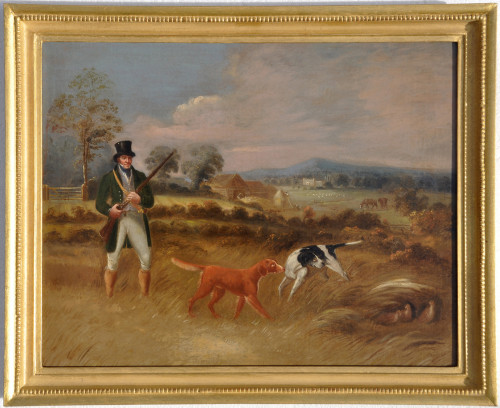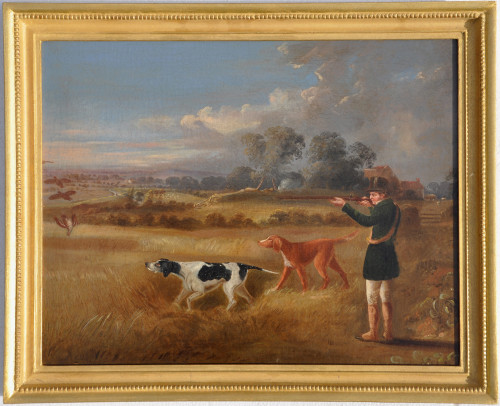A still life of game with a gun and powder flask at the base of a tree; a view to a landscape beyond
A still life of game with a gun and powder flask at the base of a tree; a view to a landscape beyond
JAKOB BOGDANI
Hungarian School
1658-1724
A still life of game with a gun and powder flask at the base of a tree; a view
to a landscape beyond
Oil on canvas, signed
64 x 99 cms
25¼ x 39 inches
Overall framed size 82.3 x 117.3 cms
323/8 x 461/8 ins
Jakob Bogdani (sometimes written as Jacob and/or Bogdany) was a renowned painter of birds, particularly exotic species, and his paintings, produced in a bright and luminous manner, often included numerous species crowded onto the canvas but with a good sense of spaciousness. He can be regarded as the foremost painter of exotic birds and still life covering the period from the late 17th century into the early 18th, a mantle he took over from the Dutch master Melchior de Hondecoeter (1636-1695)
He was born on 6th May 1658 in Eperies (now Preŝov) in Sáros County, Slovakia, then part of the Habsburg Kingdom of Hungary, the son of Lewis and Susanna Bogdani. The family were Protestants in a Catholic dominated country which may explain the family’s move, firstly to Vienna in the mid-1670s, and it was here that he received the majority of his artistic instruction, before moving to Amsterdam in 1684, one of the great centres of northern European art. In 1686, he was in the studio of the German still-life painter Ernst Stuven (c.1657-1712) who had himself studied under Willem van Aelst but by 1st June 1688 he had moved to London just before William of Orange became William III of England when many Dutch architects, engineers and artists followed in his wake seeking opportunities. There has been a suggestion that Bogdani had met and knew the Duke of St Albans, who was the son of Charles II and Nell Gwyn, in Europe as the Duke returned to England in 1688 and the artist seems to have followed him. The Duke later assisted Bogdani in a lawsuit over his estate.
Bogdani settled in Tower Street, St. Giles-in-the-Fields in 1690 and soon established himself as a successful still-life painter of game and flowers as well as bird compositions. There was no specific identity that the new monarchy wished to impart; William was preoccupied with the war against France and did not display a particular affinity with the arts. Queen Anne was however, more receptive with an inclination to the decorative. This was very much at variance with the French Court of Louis XIV where the flamboyant baroque enhanced his all-powerful image, an over-bearing style which was lifted by his successors who tended more to the rococo.
The lightness of Bogdani appealed to Anne as well as did the French Jean-Baptiste Monnoyer, the designer and still-life painter. One of Bogdani’s earliest commissions in England was for a set of flower designs for Queen Mary’s “Looking Glass Closet” in the Water Gallery of Hampton Court Palace, a joint project with Grinling Gibbons, in 1694. Queen Anne said of him that she was: “…pleas’d with his performances and encourag’d him much”. From 1698-9 he was painting flower pieces to decorate the Duke of Devonshire’s new house at Chatsworth. He was probably in the Dutch Republic around 1700 working on paintings for King William’s castle in Dieren. He also produced twenty-two pieces for Huis de Voorst which was the Dutch seat of the Earl of Albemarle.
The majority of his early decorative work was for floral pieces before moving more towards birds and game later in his career. An important and influential early patron who helped in this shift of emphasis was Admiral George Churchill, brother to the Duke of Marlborough, and the Admiral had a famous aviary at Ranger’s Lodge in Windsor Park which provided an ideal opportunity for studying and portraying them on canvas. Churchill had rented the Lodge in 1706 and then started building the aviary and collecting for it, devoting all his time to it after his retirement from the Navy in 1708. It contained a multitude of birds and some animals in this collection and Bogdani worked there studying and painting from 1708 until Churchill’s death on 8th May 1710. Queen Anne then purchased the set of paintings from his estate for the Royal Collection.
Paintings of birds in England had principally portrayed farm or game birds with peacocks, which although not indigenous, had become naturalised in perception, together with pheasants being the sole tokens of the exotic. Expanding European travel to new and distant lands with drawn records by artists accompanying these expeditions as well as taxidermy specimens, entirely new species began to become more generally known. Bogdani had a small collection of stuffed animals in his studio which he could depict in a landscape setting but with menageries and aviaries increasingly available, opportunities for more naturalistic portrayals greatly increased. His preferred method was to paint “…in the Spring, flowers and in the Somer flowers and fruits when they are out, Lobsters and oyster pieces. In the Winter, pieces of Fowell and plate”. He favoured country park settings and the birds within them are engaging with each other, or flying or walking, imbued with movement, all with a sense of liveliness and vibrancy. He would mix exotic macaws, cockatoos, scarlet ibis etc. with colourful English birds such as blue tits, woodpeckers and bull finches and liked to create an eye-catching highlight with the inclusion of a bird with bright red plumage such as a northern cardinal or red avadavat. Some of the props from his collection had a long usage such as the bullfinch and a stuffed mouse which although almost certainly no longer in pristine collection, had significant importance and attachment for Bogdani. He wished for them to continue in artistic service after his death for in his will he stated: “…all my models I give to my said son William Bogdani and to my said son in law Tobias Stranovius and his wife and I will that the same may be divided between them by lots and not be publickly disposed of.”
Bogdani took considerable care getting the anatomy of birds correct and the meticulously painted feathers are a distinction of his paintings. Christine Jackson, in her book of 18th century bird painting, writes that: “…it is the eyes of his birds that are the most remarkable feature. They are painted with a trompe l’oeil effect and look like small beads that could easily be picked off the canvas. In many cases, it is his manner of painting the actual small glass beads with which mounted specimens were provided for eyes which gave cause for this effect. However, even the eyes in Bogdani’s living models have the same appearance.”
In 1693, Bogdani had married Elizabeth Hemmings from St Andrew’s in Holborn and between 1696 and 1701, they had four children together, three of whom were baptised in in St Paul’s Covent Garden and one in St Giles. He gained English naturalisation on 11th April 1700. His considerable success made him wealthy enabling his purchase of further properties in Spalding in Lincolnshire as well as a residence in Finchley and in Hitchin in Hertfordshire. With this last property he became also lord of the manor.
He died aged 66 at his home in Lincoln Inn Fields and was buried on 11th February 1724 in the churchyard of St Mary’s, Finchley, leaving his estate to his daughter Elizabeth and her husband, the Romanian-born bird and still life painter Tobias Stranover, (1684-1756) who had immigrated to England. Bogdani’s wife had pre-deceased him in 1722. His main legacy was his influence on flower and game still life and bird painting in England and he had a direct influence on not only Stranover but also Marmaduke Cradock (1660-1717) who initially had been working closer to the style of Francis Barlow.
Paintings by Jakob Bogdani can be seen in the following museums and collections: Victoria and Albert Museum; Fitzwilliam; Hampton Court Palace; Government Art Collection; Nottingham City Museum and Art Gallery (which has a superb and unusual painting in that it only depicts two Icelandic falcons in a very spare setting); The Higgins, Bedford; Maidstone Museum and Bentlif Art Gallery; Hospitalfield; Milntown House; Worcester College, University of Oxford; Maryhill Museum of Art; National Trust: Angelsey Abbey, Wimpole Hall, Kedleston Hall, Croft Castle; National Trust for Scotland: Hill of Tarvit Mansionhouse; Museum of Fine Art, Budapest; Hungarian National Gallery; Stockholm; Yale Center for British Art.
Bibliography:
Bird Painting; the Eighteenth Century – Christine E Jackson
Dictionary of British 18th Century Painters – Ellis Waterhouse
Painting in Britain 1530-1790 – Ellis Waterhouse
Court Painting in England from Tudor to Victorian Times - William Gaunt
Rijksbureau voor Kunsthistorische Documentatie
Dimensions:
RELATED ITEMS
























